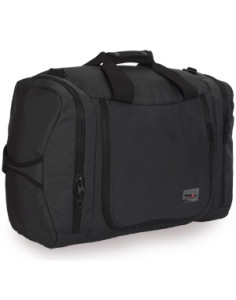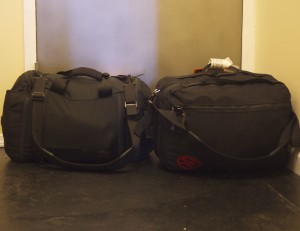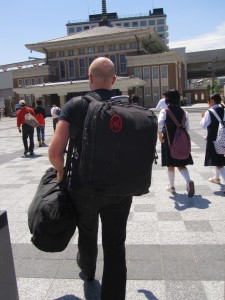
When writing a review of anything, I will always try to be upfront with you about any biases I may have about a company or product — for or against.
So before I launch into this review of the other bag we brought on our Round-the-World trip — the Tom Bihn Aeronaut — I need to disclose the following:
I really like Tom Bihn.
I really like their products. I really like the people that I’ve talked to who work there. I like their “corporate ethos”. I like their customer service. I like the little red airplane on their logo ((A Farman F–121 Jabiru)). And based on some interviews I’ve read which featured him, I think I’d probably like Tom-Bihn-the-guy as well. (Follow Up — I recently met Tom and my instincts were right: He’s a wonderful guy!)
Now that my “bias” has been disclosed, let’s move into the heart of the matter: The Aeronaut is my favorite bag for extended travel and this review will attempt to explain why that is! ((Okay — maybe the little red airplane thing on their logo is also a pre-existing bias: I loves me some old-timey travel stuff!))
I had never even heard of Tom Bihn until earlier this year. As you might remember from previous installments, I had been spending a lot of time researching and trying to find the right bags for Lauren and I before we left on our “Round-the-World Honeymoon”.
I had already found one (the Red Oxx Sky Train) which was a great bag. But after spending some time with it, I felt that it was just a little too small for me to live out of for three months. Although the Sky Train had almost 2,400 cubic inches of space (about 38 liters and change), I knew that it would literally stretch things to the breaking point if I tried to jam all my clothes, cables, adapters, toiletries, etc. inside of it.
The Sky Train’s compartments also had a layout that didn’t make a lot of sense for what I was traveling with: Me being me… I had a lot of electronic gear that I needed access to while in transit — and I didn’t want my clothing to fall out or to be exposed while doing so.
After seeing how much the bag expands when fully packed, I realized that bringing everything I needed would make the Sky Train too big to fit it into an overhead compartment. I needed a bag that had more volume than the Sky Train — but which spread it out along its length, not its depth. I also needed a couple of small compartments to access key items without exposing my clothes.
Enter the Tom Bihn Aeronaut…
The Details
[table id=1 /]
I learned about the Tom Bihn Aeronaut from a number of online forums and knew that it was a well-regarded bag among heavy travelers. Its length was longer than the Sky Train and also had a little more volume — 45 liters (2,700 cu. in.) compared to the Sky Train’s 38 liter capacity. It seemed to be what I was looking for, so I ordered one — along with their upgraded strap and a number of packing cubes and accessories. The online store was easy to navigate and my stuff shipped the very next day.
After unboxing the Aeronaut and accessories, I looked everything over carefully and was pleased by what I saw. Comparing the two bags, the Aeronaut matched the quality of the Red Oxx bag at every turn and I realized that I actually preferred it to the Sky Train. The Red Oxx is a great bag and it took me a while to figure out why I liked the Aeronaut better — both aesthetically and functionally. Trying to put my finger on why this was so, I realized it came down to two main things: The material that each bag was made out of… and the layout of the bags themselves
“What The Hell Is A “Denier”?”
I looked at each bag’s specification sheet to start my comparison. The Aeronaut’s exterior is made of “1050 denier Ballistic Nylon”, while the Sky Train is made of “1000 denier Cordura Nylon”. Those two descriptions seem almost identical, but the texture and feel of these materials were clearly different from each other — obvious even to a textillary illiterate like me. I wanted to understand why.
I discovered that the term “denier” refers to the weight of a fabric, and it’s a word you’ll usually see only in footnotes and specification sheets as you shop for bags. When you read about the weight of a fabric, often times that’s just a shorthand for the density of the fibers that make up the material. The combination of the fiber used, how it’s chemically treated, and the density and way in which those fibers are woven together gives a fabric its strength.
It’s a complicated thing and higher denier numbers don’t always equal stronger materials. And in any event, heavier fabric isn’t always better. A designer is usually trying to hit the “sweet spot” between how strong something is versus its physical weight — as well as the ease with which you can sew it into a functional shape.
Putting the Red Oxx next to the Aeronaut, you can see the characteristics of each fabric weave very clearly. The Aeronaut is shiny, where the Sky Train has a flat matte finish. I’ve read that Ballistic Nylon is more difficult to dye, so you’ll usually see it offered in black or other darker colors. Anecdotally, this seems to be true — The Sky Train is currently available in 12 colors, the Aeronaut in 4.
Wear and Tear
Both Cordura and Ballistic Nylon have superior abrasion resistance and a tear strength that is more than twice the lighter (and more commonly used) 1680 ballistic nylon fabric. I’ve also seen it claimed that “1050 denier fabric is the strongest and most durable fabric for its denier weight level”. I wasn’t able to verify that but, to my eye, the Aeronaut seemed exceptionally rugged when compared to the weight of the material. To give you a different sense of it, I’ve read that cheaper bags sometimes use the same Ballistic Nylon that the Aeronaut is made from to strengthen the bottoms of their bags. Personally, I like that my whole bag was made from the strong stuff.
In my experience, Ballistic Nylon also wears incredibly well: After 40,000+ miles of travel in 3 months (about 65,000 kilometers), the bag looked almost new when I set it down inside the front door upon our return. The Sky Train looked pretty good as well, but it was a bit more scuffed up from its journey.
The material differences of each bag also created different experiences in other ways. The Aeronaut’s Ballistic Nylon construction gives it a smoother, easier sliding surface than the Red Oxx — something I appreciated as I was putting the bag into and out of overhead compartments. In my review of the Red Oxx, I shared a story of how on our first flight, the Sky Train had expanded so greatly that we couldn’t wedge it into the overhead. The part of the story which I haven’t mentioned until now is that the Aeronaut, packed with even more stuff than the Sky Train, slid into the compartment smoothly.
No problem. Like buttah.
That incident is also as good a place as any to start talking about the design of the bag itself.
THE DESIGN
When you browse around the Tom Bihn website, it won’t be long until you run into this Latin quote: “Siquid mantica non capit, domi relinquendum est.“, which translates into ‘If it doesn’t fit in your knapsack, leave it behind.’ Luckily for me, the Aeronaut was large enough to not have to leave behind anything important. Although I didn’t always carry everything in the Aeronaut, I was able to do so if I needed to. In all, it carried 10 days worth of clothes in two “packing cubes”, my laptop, a small shoulder bag for my iPad, a toiletry bag, a bag for all my many chargers and adapters, my jacket, beach shoes, some small souvenirs, a laundry bag, and various papers and documents.
Almost all of the smaller bags were Tom Bihn accessories and each would have been great in their own right no matter what bag I had taken. Frankly, though, they worked out even better since they had been designed to fit into the Aeronaut’s compartments. One accessory deserves special mention: The Absolute Shoulder Strap. The awesome, springy qualities of this strap made carrying a bag on the shoulder much more comfortable — so much so that I bought one for the Red Oxx as well. Be sure to get one!
Both the Sky Train and the Aeronaut are “hybrid bags” — carry-ons which convert into backpacks. However, it felt like each bag was coming from the opposite side of that spectrum to meet in that middle place. The size and shape of the Sky Train made it feel like it was a backpack first and a carry-on second — and the padding of its shoulder straps certainly buttressed this impression as they are much thicker than the Aeronaut’s.
The Aeronaut’s design suggests that, at heart, it’s a top-loading duffel bag with side compartments. The backpack straps are certainly useful (and useable) but, where the Sky Train was happiest when carried on the back, Aeronaut seemed happiest when over the shoulder. This difference actually came in handy on those rare occasions where Lauren needed me to carry her bag as well.
The rigidity of the ballistic nylon also gave Aeronaut a more structured feel to me that the Sky Train. This is a matter of personal preference, I suppose. But as exemplified by my experience on our very first flight, I liked knowing that I could stuff the Aeronaut to the hilt and that it would still keep its shape well enough to fit in the overhead. ((Although with about 36.5 lbs. of stuff inside (16.5 kg), I did have it packed so completely that it began to curve like a banana….))
***
I have heard it said you can tell a good design by this maxim: Whenever you reach for something, you’ll find that it’s there.
When I contacted Darcy Gray, VP of Tom Bihn, to ask her about Tom’s inspiration for the design of this bag, she wrote back with an answer from Tom himself:
My dad was a pilot for Pan Am: needless to say I grew up traveling a lot. Since I was just a kid, I’ve spent time watching how people use their luggage, and using some myself as well. When I decided to design a travel bag, what became the Aeronaut was just the obvious conclusion to years of use and observation. I wanted clean lines so the thing wasn’t an eyesore, convenient pockets and useful organization, and the ability to carry it different ways depending on need at the moment.
All those years of observation have paid off beautifully in the form of the Aeronaut. Over and over on this trip, I found myself realizing that I needed my bag to do something — only to find that Tom Bihn had already anticipated that need and built it in to the Aeronaut.
The Aeronaut’s design is thoughtful and elegant — with special attention paid to the “small” details. To me, finding a bag maker like Tom Bihn was like finding the Apple Computer of Luggage. And now that I’ve made the switch, it’s hard to imagine going back to anything else.


Ok so while your review of the Aeronaut was helpful and is what made me decide to go with Tom Bihn, you didn’t do it justice!! I just got my bag yesterday and this is a GREAT BAG!! I don’t know why you would use any other bag for one bag travel. It is everything you said and more. It’s roomy, the craftsman ship is outstanding, and you can see that this bag will last a VERY long time. Thank for your review!
I am always mindful of how many exclamation points I use (because I use them a lot) but, clearly, I didn’t use enough this time around. 😉
Glad the review helped and steered you towards this awesome bag/company. My Aeronaut is still my primary bag and it’s looking great — even after putting almost 170,000 miles on it.
FYI — In 2013, I’m planing on reviewing a few more TB products while I travel.
Great review.
Interesting that most online reviews state that the backpack straps of the Aeronaut are superior while you have reached the opposite conclusion. Could you expand your comments on that specific area?
Thanks Mike!
Both the Red Oxx and the Aeronaut have *really good* backpack straps! To me, though, the padding on the straps of the Sky Train feels more robust.
But that’s not the whole story: The Sky Train’s metal hardware (which locks the backpack straps into place) is much heavier than the plastic clips on the Aeronaut’s. This can be a good or a bad thing, depending on your personal preferences. In our case, one of these clasps bent early in our travels, which made it hard to quickly convert the bag from shoulder carry to backpack mode.
I also prefer the way the Aeronaut feels when I’m wearing it as a backpack. Generally speaking, my bags are fully loaded when I travel and the Aeronaut distributes this along a longer — not a deeper — axis. In practice, this means that I’m less worried about inadvertently whacking someone with my bag as it’s gives me a narrower footprint while walking down the street.
Two and a half years (and probably 150,000+ miles worth of travel) since getting the Aeronaut, it still looks basically brand-new and it’s still is my bag of choice when going anywhere.